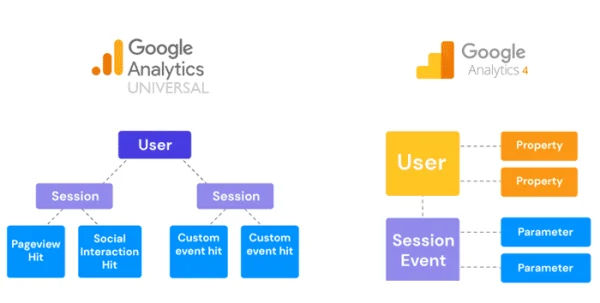GA4 vs universal analytics

Newsthree.biz.id Assalamualaikum In This Time I will discuss the benefits of MANY ADVANTAGES that should not be missed. Article Reports About MANY ADVANTAGES GA4 vs universal analytics Come on
Table of Contents
GA4 vs Universal Analytics: Key Differences and Implications
**GA4 vs. Universal Analytics: Key Differences and Implications**
Google Analytics 4 (GA4) is the latest iteration of Google's analytics platform, replacing Universal Analytics (UA). While both tools serve the purpose of tracking website and app data, they differ significantly in their capabilities and implications.
**Data Collection and Processing**
One of the most fundamental differences between GA4 and UA lies in their data collection and processing methods. GA4 utilizes an event-based data model, capturing every user interaction as an event. This granular approach provides a more comprehensive understanding of user behavior. In contrast, UA relies on session-based data, which aggregates user interactions within a specific time frame.
**Reporting and Analysis**
GA4 introduces a revamped reporting interface that emphasizes user-centric metrics and customizable dashboards. It offers pre-built reports tailored to specific business objectives, such as customer acquisition and engagement. UA, on the other hand, provides a more traditional reporting structure with a focus on pageviews and sessions.
**Machine Learning and Predictive Analytics**
GA4 leverages machine learning algorithms to enhance data analysis and provide predictive insights. It can automatically identify trends, anomalies, and potential opportunities. UA lacks these advanced capabilities, relying primarily on historical data for analysis.
**Cross-Platform Tracking**
GA4 is designed to track data across multiple platforms, including websites, apps, and even offline interactions. This cross-platform tracking capability enables a more holistic view of user behavior and allows for more accurate attribution. UA, on the other hand, is primarily focused on website tracking.
**Privacy and Data Protection**
GA4 adheres to stricter privacy regulations, such as the General Data Protection Regulation (GDPR). It offers enhanced data privacy controls and anonymization features to protect user information. UA, while still compliant with privacy regulations, does not provide the same level of data protection as GA4.
**Implications for Businesses**
The transition from UA to GA4 has significant implications for businesses. Organizations need to consider the following:
* **Data Migration:** Businesses must migrate their existing data from UA to GA4 to ensure continuity.* **Reporting Adjustments:** The new reporting interface and metrics in GA4 require businesses to adjust their reporting and analysis processes.* **Training and Adoption:** Employees responsible for data analysis and reporting will need to be trained on the new GA4 platform.* **Data Privacy Compliance:** Businesses must ensure that their GA4 implementation complies with relevant privacy regulations.
In conclusion, GA4 and UA are distinct analytics platforms with different capabilities and implications. GA4 offers a more comprehensive data collection model, advanced reporting and analysis features, cross-platform tracking, and enhanced privacy protection. Businesses should carefully consider these differences and plan for a smooth transition to GA4 to maximize the value of their analytics data.
Migrating from Universal Analytics to GA4: A Step-by-Step Guide
**GA4 vs. Universal Analytics: A Comprehensive Comparison**
As businesses navigate the digital landscape, understanding the differences between Google Analytics 4 (GA4) and Universal Analytics (UA) is crucial for effective data analysis and decision-making. While both platforms provide valuable insights into website performance, they differ significantly in their capabilities and approach.
**Data Collection and Measurement**
GA4 employs an event-based data collection model, capturing every user interaction as an event. This granular approach allows for more comprehensive data analysis and customization. In contrast, UA relies on session-based data collection, which groups user interactions into sessions, potentially missing out on valuable insights.
**User-Centric Focus**
GA4 prioritizes user-centric data, focusing on individual user behavior rather than aggregate metrics. It introduces concepts like user ID and user lifetime value, enabling businesses to track and analyze the entire customer journey across multiple devices and touchpoints. UA, on the other hand, primarily focuses on website-level metrics.
**Machine Learning and Predictive Analytics**
GA4 leverages machine learning algorithms to enhance data analysis and provide predictive insights. It can automatically detect anomalies, identify trends, and predict future outcomes, empowering businesses to make data-driven decisions. UA lacks these advanced capabilities.
**Cross-Platform Compatibility**
GA4 is designed to track data across multiple platforms, including websites, mobile apps, and even offline interactions. This cross-platform compatibility provides a holistic view of user behavior and enables businesses to optimize their marketing efforts across channels. UA is primarily focused on website analytics.
**Data Retention and Privacy**
GA4 offers flexible data retention options, allowing businesses to choose the duration for which data is stored. It also complies with evolving privacy regulations, such as the General Data Protection Regulation (GDPR). UA has a fixed data retention period of 26 months.
**Migration Considerations**
Migrating from UA to GA4 requires careful planning and execution. Businesses should consider the following steps:
* **Set up GA4 property:** Create a new GA4 property and link it to your website.* **Configure data collection:** Ensure that GA4 is collecting the necessary data by configuring events and parameters.* **Map data sources:** Establish relationships between UA and GA4 data sources to facilitate data comparison and analysis.* **Monitor and evaluate:** Regularly monitor the performance of GA4 and compare it to UA data to identify any discrepancies or areas for improvement.
By understanding the key differences between GA4 and UA, businesses can make informed decisions about which platform best aligns with their data analysis needs. GA4's advanced capabilities, user-centric focus, and cross-platform compatibility make it an ideal choice for organizations seeking comprehensive and actionable insights into their digital performance.
Unlocking the Power of GA4: Advanced Features and Use Cases
**GA4 vs. Universal Analytics: Embracing the Future of Web Analytics**
Google Analytics 4 (GA4) has emerged as the successor to Universal Analytics, offering a transformative approach to web analytics. While both platforms share the core purpose of tracking website performance, GA4 introduces significant advancements that empower businesses with deeper insights and enhanced capabilities.
One of the key differences between GA4 and Universal Analytics lies in their data collection model. GA4 utilizes an event-based data model, capturing every user interaction as an event. This granular approach provides a more comprehensive understanding of user behavior, enabling businesses to track specific actions and measure their impact.
GA4 also introduces enhanced reporting capabilities. Its intuitive interface and customizable dashboards allow users to tailor their analytics experience to their specific needs. The platform offers a wide range of pre-built reports and visualizations, making it easier to identify trends and draw meaningful conclusions.
Furthermore, GA4 integrates with Google's other marketing tools, such as Google Ads and Google Search Console. This seamless integration enables businesses to connect their analytics data with their marketing campaigns, providing a holistic view of their digital marketing efforts.
Another notable advantage of GA4 is its focus on privacy and data protection. The platform complies with the latest privacy regulations, such as the General Data Protection Regulation (GDPR), ensuring that user data is handled responsibly and securely.
However, it's important to note that the transition from Universal Analytics to GA4 requires careful planning and execution. Businesses should consider their specific needs and resources before making the switch. GA4 offers a more advanced and comprehensive analytics solution, but it also requires a higher level of technical expertise to implement and interpret the data.
In conclusion, GA4 represents a significant evolution in web analytics. Its event-based data model, enhanced reporting capabilities, and seamless integration with Google's marketing tools provide businesses with unprecedented insights into their website performance. While the transition to GA4 may require some effort, the benefits it offers make it a worthwhile investment for businesses seeking to optimize their digital presence and drive growth.
That is the discussion about ${title} that I have explained in many advantages Thank you for trusting us as a source of information look for new opportunities and maintain your stamina. Spread kindness by sharing it with others. hopefully the next other article is interesting. Thank you.








✦ Tanya AI